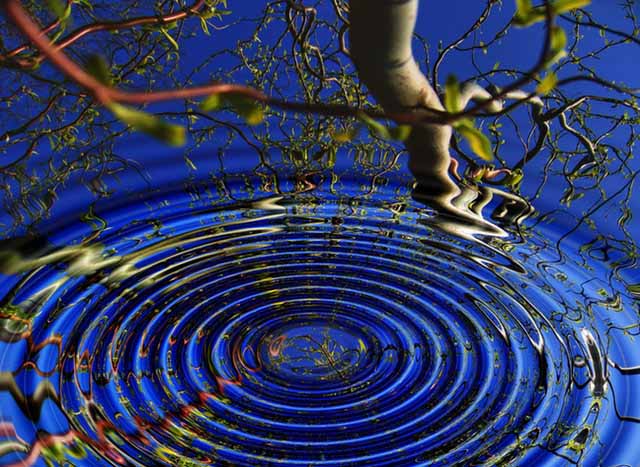Liberation: Spiritual Freedom Now or Later
Spiritual liberation is realization of our innermost essence, the Self. This can occur after death or even before the body and mind have disintegrated. The latter form of freedom is known as “living liberation.” If it qualitatively the same as the former and is often known as enlightenment.
In both cases, the mind must be fully transcended. That is to say, there must be nothing in the way of pure awareness. While we are alive, Self-realization is a paradoxical state. On one hand, there is the disembodied, eternal Self, and on the other hand, there is the infinite body and an equally finite mind. This is a mind boggling combination!
The Self-realized adept who is alive has pushed the mind to its limits, such that it barely exists at all. Certainly, the adept’s mind includes no tendency to ward self-centeredness. In some cases, the master may spend more time being present as the Self. In (most) other cases, he or she dips into actual Self-realization periodically, which then has a profoundly transformative effect on the mind. Put differently, in the Self-realized adept, the Self – or God – is more present than the mind.
The process of Yoga is an unveiling of the ever-present Self. We are always free, or liberated. But the blocks in our mind prevent us from recognizing our innate freedom. This is comparable to a tree branch standing in the way of the Sun. When we bend the branch a little, the sunlight strikes our eyes. When we remove the obstructions in the mind – all the negative emotions like anger, lust, greed, and so on – we can welcome the light of the Self in our heart. Even a little bit of the yogic work can give us a glimpse of the Self. In a way, every step toward the Self is liberating.
Yoga is thus excavation work, which gets rid of the dross in the psyche. At first, this requires a very muscular effort. We have to apply ourselves systematically using willpower and self-discipline. Imagine spade and pickaxe. Later on, the yogic work becomes more subtle but also more challenging, because the impediments are not always easy to see. When you are still in the process of dismantling gross self-centeredness, you will in general know what to do. More subtle forms of self-centeredness involve mental obstacles that call for great discernment. It may not always be obvious to a disciple even which functions of the mind are self-centered. This is where a guru can be supremely helpful. He or she has struggled with the same or a similar problem.
Being more skilful on the ecstatic circuit of the spiritual path, the guru can point out where we are getting sidetracked. The experience of ecstasy – either in its lower forms or by dint of artificial means (such as drugs or mantras) – can itself be full of traps. Not every ecstasy reveals the Self. The ecstatic state can, however, look like the real thing. Only superior discernment – like a teacher is apt to have – will settle the matter.
Whenever we are close to Self-realization, our conduct is likely to become simple and inspiring to others. The nondual Self, after all, is simple. As long as our life is overly convoluted, or complicated, we are still closer to the mind than to the Self. On the spiritual path, the mind is progressively stripped of the need for complication and extraordinariness. In fact, disciples are to all appearances ordinary people. They don’t wear a special sign that proclaims: “I am a disciple.” Nor do disciples engage in extraordinary feats. If they do, then we ought to question their spiritual status. To behave in an ordinary manner while being extraordinary on the inside is a sign of freedom.
The freer we are, the less likely do we feel the urge to assert ourselves or display our specific neuroses. The liberated being is non-neurotic. He or she has overcome the wiles and compulsions of the mind.
By Brenda and Georg Feuerstein (An excerpt from “The Matrix of Yoga: Teachings, Principles, and Questions” by Georg and Brenda Feuerstein. Used with permission from Brenda Feuerstein)
 Brenda Feuerstein will be leading our SOYA Annual Yoga Retreat at Sorrento Centre this May 31-June 2nd! An event not to be missed! Register Here! She is an author and yoga scholar. Her books include The Yoga-Sutra from a Woman’s Perspective, Yoga-Nidra/Yoga Sleep (audio recording) as well as co-authored works with her late husband and spiritual partner Dr. Georg Feuerstein include, The Matrix of Yoga, Green Yoga, Green Dharma, and The Bhagavad-Gita: A New Translation. She lives in the quaint village of Eastend, Saskatchewan. Photo credit: Free download from Pixabay at https://www.pexels.com/photo/abstract-art-awareness-branches-268283/
Brenda Feuerstein will be leading our SOYA Annual Yoga Retreat at Sorrento Centre this May 31-June 2nd! An event not to be missed! Register Here! She is an author and yoga scholar. Her books include The Yoga-Sutra from a Woman’s Perspective, Yoga-Nidra/Yoga Sleep (audio recording) as well as co-authored works with her late husband and spiritual partner Dr. Georg Feuerstein include, The Matrix of Yoga, Green Yoga, Green Dharma, and The Bhagavad-Gita: A New Translation. She lives in the quaint village of Eastend, Saskatchewan. Photo credit: Free download from Pixabay at https://www.pexels.com/photo/abstract-art-awareness-branches-268283/
Celebrating 30 Years of yoga teacher training excellence in 2025


Recent Comments